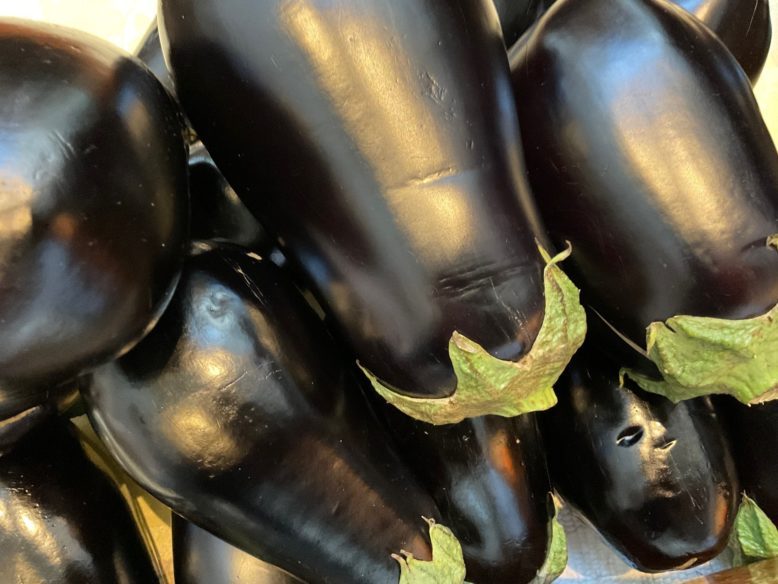
Did you know that New Jersey is the top eggplant producer in America?
It’s true! In 2019 and 2020, the Garden State harvested over 16 million pounds of eggplant, valued at $6 million, which was significantly more than the next largest eggplant-producing states, including California, Florida and Georgia. The majority of our eggplant production is located in South Jersey, especially Gloucester, Cumberland, Salem and Atlantic Counties. Smaller production sites are also located in Monmouth and Burlington Counties.
Production is mainly for wholesale shipment to the eastern United States and Canada depending on the time of year, and a small volume of eggplant is produced in the northern part of the state for roadside stands and farmers’ markets.

Produce Pete discusses how to select and store eggplant for NBC Weekend Today in New York. Photo courtesy of Pete Napolitano
Eggplants are harvested by hand one to two times a week, depending on temperature. Because they need well-drained, sandy-loam soil to grow, New Jersey offers the perfect conditions for this purple plant. Ferrari Farms, R & R Flame Farms, and Scapellato Farms in South Jersey are huge eggplant growers, and friends of mine. The eggplants in their fields are a beautiful sight.
When I was a young man running our family’s produce store in Bergenfield, I would buy from my local farmers all season long. I remember getting fresh peppers and eggplants picked one day at Binaghi Farm in Old Tappan, as well as at Smith Farms just over the border in New City, New York. Farmers like Wally Smith and Ronnie Binaghi were more than business partners to me and my family; they were friends who felt more like extended family.
All About Eggplants
Eggplants got their name because they used to come in only one color—white—and looked like eggs hanging from the plant. Because they tended to bruise easily during shipment, hybridizers began developing eggplants that wouldn’t scar and, in the process, widened the variety.
A member of the nightshade family, eggplants produce beautiful, star-shaped blue-violet flowers early in the growing season; the eggplant is the berry that forms after the flower drops. The most commonly available eggplant is a deep shade of purple, and ranges in size from four ounces to 1.5 pounds. The original white eggplant is actually quite trendy now; it’s generally smaller than the purple variety and is also more expensive because it’s not as widely cultivated.
Baby or Italian eggplants have long been popular on the East Coast and are widely available from July through September/October. In sunnier climates, they’re available year-round, though supplies may be limited. Other varieties are generally available year-round, and fall is a great time to enjoy them.
Eggplants are high in vitamins C, K and B6, as well as fiber and cancer-fighting antioxidants. In addition, compounds in the eggplant’s deep pigment help strengthen bones and combat osteoporosis, while the eggplant’s phytonutrients help boost brain function.
Selection and Storage
Eggplants can be round, oval or pear-shaped and may be white, purple or striped in color. The flesh is firm and creamy white with a lot of edible white seeds in the center. Baby or Italian eggplants are smaller with thinner skin.
When choosing an eggplant, look for firm, shiny fruit that’s heavy for its size (if it’s large but feels light, it will be pulpy). The top should be green and fresh-looking. A green cap with little spikes around the stem indicates that the eggplant is fresh.
Next, look at the blossom end. If it has a round mark, it’s a male. If the mark is oval (slightly elongated), it’s a female. Female eggplants are firmer and contain fewer seeds; the fewer seeds an eggplant has, the less bitter it will taste.
Finally, if you press the flesh gently with your thumb and it leaves an indentation, pass that eggplant by. Unless you’re making gumbroit—an old-style ratatouille-like dish made with eggplant, squash, tomatoes and other vegetables—the eggplant should be firm with no wrinkling or soft spots. If it’s the purple variety, it should be smooth and shiny, not dull.
Store eggplant at room temperature on the cool side, or wrap it loosely and store in the crisper drawer of your refrigerator. A firm eggplant will keep for several days.
Preparation
Eggplant has a slightly bitter taste, especially when mature. To get rid of that, peel the eggplant (the skin is likely to be both bitter and a little tough), then slice it, sprinkle slices with salt and allow to drain in a colander for up to half an hour. In addition to purging the bitter juices, salting eggplant also helps keep it from absorbing oil when you sauté or fry it.
You can bread and fry eggplant or use it in dozens of different vegetable dishes. Two of my favorites are my wife Bette’s eggplant rollatini with tomato sauce and her eggplant Parmigiana, which she makes with alternating layers of eggplant, cheese and sauce. Roll up your sleeves and dig into her recipe for this hearty dish, starring one of New Jersey’s best homegrown products.
Bette’s Excellent Eggplant Parmigiana
- 3 large eggplants
- Egg and milk mixture for coating eggplant slices
- Oil for frying
- Bread crumbs
- Salt to taste
- 1 pound mozzarella cheese, shredded
- ½ cup Parmesan cheese, grated
- Prepared tomato sauce
Preheat the oven to 350 degrees. Cut unpeeled eggplant into slices (about 1/8-inch or 1/4-inch thick). Dip eggplant into egg and milk mixture, then into bread crumbs. In a large frying pan, heat oil until very hot. Fry eggplant on both sides until golden brown; drain on paper towels. Cover the bottom of a large baking pan with sauce, followed by a layer of eggplant slices, more sauce, mozzarella cheese and Parmesan cheese. Repeat these layers, ending with tomato sauce, mozzarella and Parmesan cheese on top. Bake for 25–30 minutes, and enjoy!
About “Produce Pete” Napolitano
With over 65 years of experience in the produce industry, New Jersey’s own “Produce Pete” Napolitano is a renowned fruit and vegetable expert, author, and TV personality who’s appeared on a highly popular segment on NBC’s Weekend Today in New York, broadcast every Saturday morning for over 28 years. For more information, visit producepete.com.
About Susan Bloom
A regular contributor to New Jersey Monthly and a variety of other well-known local and national publications, Susan Bloom is an award-winning New Jersey–based freelance writer who covers topics ranging from health and lifestyle to business, food and more. She’s collaborated with Produce Pete on a broad range of articles for over a decade.
